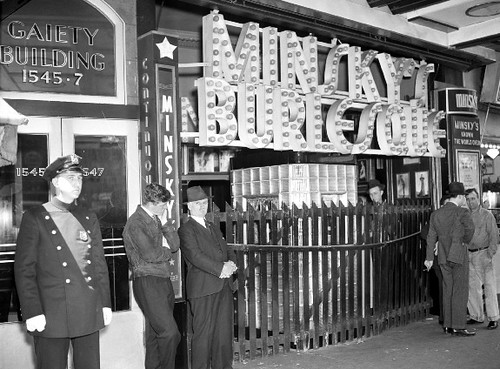 Now a popular urban destination, Times Square welcomes millions of tourists each year. The “square” forms a deep X and spans West 42nd to West 47th Streets along Broadway and 7th Avenue. “Fiery neon signs” and “jumbo billboards” 1 light the square. Theatres, museums, and restaurants engage passersby. Termed “No. 1 Tourist destination” 2 by Travel + Leisure Magazine, Times Square generates $1 of every $9 of municipal economic activity. Annual revenue exceeds $100 billion and will continue to soar, due, in large part, to a $27 million municipal redesign. 3 Times Square is bright, but its future is brilliant.
Now a popular urban destination, Times Square welcomes millions of tourists each year. The “square” forms a deep X and spans West 42nd to West 47th Streets along Broadway and 7th Avenue. “Fiery neon signs” and “jumbo billboards” 1 light the square. Theatres, museums, and restaurants engage passersby. Termed “No. 1 Tourist destination” 2 by Travel + Leisure Magazine, Times Square generates $1 of every $9 of municipal economic activity. Annual revenue exceeds $100 billion and will continue to soar, due, in large part, to a $27 million municipal redesign. 3 Times Square is bright, but its future is brilliant.
Formerly “Longacre Square,” “Times Square” received its name in 1904, after the New York Times Building on 42nd St. That year, Hammerstein’s Victoria Theatre became the first theatre to run Vaudeville productions exclusively. Unable to meet financial demands, the theatre folded a few years later.
The Hippodrome opened the following year as the world’s largest theatre. To capture new audiences, the theatre charged 25 cents per ticket, significantly lower than the standard $2 fare. Daily matinees showcased an “eclectic mixture of circus, ballet and avant-garde acts.” In later years, the woebegone theatre accommodated vaudevilles, movies, and boxing and wrestling matches, before closing in 1939 due to poor ticket sales and exorbitant real estate costs.
The 1914-1915 season produced a “record breaking 133 productions at 42 theatres staged in and around Times Square.” Reasonably priced, family-friendly shows attracted theatregoers of varying socioeconomic backgrounds. No longer an indulgence, theatre became a regular means of recreation… until the advent of film and onset of the Great Depression halted Broadway’s ephemeral heyday.
 In the 1930s, waves of city residents migrated uptown (where rent was cheaper) and deserted Times Square. Low attendance and impossible real estate costs forced theaters to close. In place, entrepreneurs constructed saloons and brothels. These, along with “burlesque halls, vaudeville stages, and dime houses,” solidified Times Squares’ “reputation for licentiousness.” May Livingston and Ann Grey exploited Times Square’s decline and managed a combined half-dozen “houses of ill-repute.” To finance their ventures, Grey and Livingston worked as chorus girls and prostitutes, simultaneously.
In the 1930s, waves of city residents migrated uptown (where rent was cheaper) and deserted Times Square. Low attendance and impossible real estate costs forced theaters to close. In place, entrepreneurs constructed saloons and brothels. These, along with “burlesque halls, vaudeville stages, and dime houses,” solidified Times Squares’ “reputation for licentiousness.” May Livingston and Ann Grey exploited Times Square’s decline and managed a combined half-dozen “houses of ill-repute.” To finance their ventures, Grey and Livingston worked as chorus girls and prostitutes, simultaneously.
By the early 40s, most Depression-ravaged theatres closed and reopened as X-rated movie houses, “a staple of Times Square for many years to come.” The 60s, 70s, and early 80s saw further decline in theatre attendance and an increase in number of movie houses and adult stores. 4
In the late 80s, chagrined city and business owners “slowly joined together” to refine Times Square and renovate landmark buildings. Times Square BID (Business Improvement District) invested nearly $4 billion “to create the new Times Square,” a safer, more enjoyable destination. 5
 Since 2000, New York City international and domestic visitors surged from 36 million to 51 million, 80% of whom passed through Times Square. Annual Broadway ticket sales are higher than ever – now at $1.3 billion (over 100 million tickets). Times Square employs 170,000 workers, a figure that will likely rise to 200,000 by 2014. Due in 2014, Times Square Alliance works on the “modern, minimalist sprucing up” project. Now a “dumpy-looking plaza,” Times Square will receive a face-lift, “a futuristic, streamlined look and a noirish quality that evokes the square’s colorful and occasionally illicit past.” While its façade will change, Times Square will continue to abide by district-maintained commitments to public welfare and visitor gratification. 6
Since 2000, New York City international and domestic visitors surged from 36 million to 51 million, 80% of whom passed through Times Square. Annual Broadway ticket sales are higher than ever – now at $1.3 billion (over 100 million tickets). Times Square employs 170,000 workers, a figure that will likely rise to 200,000 by 2014. Due in 2014, Times Square Alliance works on the “modern, minimalist sprucing up” project. Now a “dumpy-looking plaza,” Times Square will receive a face-lift, “a futuristic, streamlined look and a noirish quality that evokes the square’s colorful and occasionally illicit past.” While its façade will change, Times Square will continue to abide by district-maintained commitments to public welfare and visitor gratification. 6
P.S. Sample a few of Times Square’s current offerings!
Recommended: M&M’s World; Ripley’s Believe it or Not; Toys ‘R’ Us; Olive Garden
- Grynbaum, Michael M. “A New Look Is Coming to Times Square: Minimalism.”Nytimes.com. Web. 1 May 2012. <http://www.nytimes.com/2011/09/28/nyregion/times-square-pedestrian-plazas-to-get-a-makeover.html?_r=2>. ↩
- “The World’s Top 10 Tourist Attractions.” USATODAY.COM. Web. 01 May 2012. <http://travel.usatoday.com/destinations/dispatches/post/2011/09/the-worlds-50-top-tourist-attractions/549231/1>. ↩
- McGeehan, Patrick. “Times Square Lights Up City’s Economy, Study Finds.”Nytimes.com. Web. 01 May 2012. <http://cityroom.blogs.nytimes.com/2012/03/19/times-square-lights-up-citys-economy-study-finds/>. ↩
- Macbeth, VR. “The Great White Way.” Timessquare.com. Web. 1 May 2012. <http://timessquare.com/NYC__/Times_Square_History/The_Great_White_Way/>. ↩
- “Blur of Excitement, 1995.” The New York Times. The New York Times. Web. <http://www.nytimes.com/specials/times-square/c-great6.html>. ↩
- Grynbaum, Michael M. “A New Look Is Coming to Times Square: Minimalism.”Nytimes.com. Web. 1 May 2012. <http://www.nytimes.com/2011/09/28/nyregion/times-square-pedestrian-plazas-to-get-a-makeover.html?_r=2>. ↩




